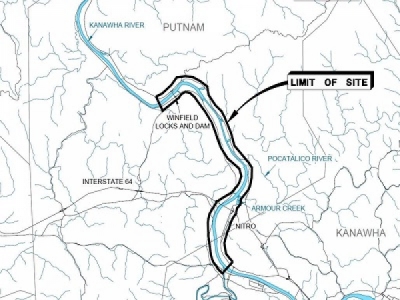
Posted on August 30, 2016
By Ken Ward Jr., Gazette-Mail
More than a dozen years after they promised to more thoroughly investigate the problem, government regulators and Monsanto Co. are joining in a proposed plan to clean up dioxin contamination from the sediment in a 14-mile stretch of the Kanawha River west of Charleston.
The U.S. Environmental Protection Agency revealed late last week that the parties all prefer an alternative that would install stone caps over certain contaminated spots in the river sediment, rather than conducting a broader and more expensive dredging project to remove material contaminated with toxic dioxin pollution from Monsanto’s former chemical plant in Nitro and from the company’s waste dumps in the area.
The EPA published a short public notice about the proposal in the Gazette-Mail Thursday, and it made available a nearly 1,500-page report that describes the study of the contamination and the consideration of various alternatives for cleaning it up.
“This was done over several years and much, much discussion,” said Joseph Gabriel, environmental remediation manager for Monsanto. “All of the options were evaluated, and the overall opinion was this was the best alternative.”
Jake McDougal, a program manager with the Department of Environmental Protection Office of Environmental Remediation, said Friday that the proposal is “a consensus agreement” between federal and state officials and Monsanto.
The cleanup — covering an area of the Kanawha to the Winfield Lock and Dam — would address toxic contamination of the river that dates back many decades, to when Monsanto began in the late 1940s to make a powerful herbicide ingredient called 2,4,5-T.
In its best-known use, the federal government bought 2,4,5-T to make Agent Orange, the defoliant deployed widely in the Vietnam War. Monsanto’s 2,4,5-T was contaminated with a highly toxic dioxin compound known as 2,3,7,8-TCDD.
Dioxin has been linked to cancer, birth defects, learning disabilities, endometriosis, infertility and suppressed immune functions. The chemical builds up in tissue over time, meaning that even small exposures can accumulate to dangerous levels.
For years, Monsanto disposed of wastes containing dioxin in dumps at Heizer and Manila creeks, north of the company’s Nitro plant. A class-action lawsuit, later settled, also alleged that Monsanto’s operations had sent dioxin-contaminated dust over the area, contaminating homes and businesses.
Repeatedly, Monsanto entered into agreements with the EPA to clean up at least some of its dioxin contamination, but the river remains contaminated to the point that anglers are warned against eating fish from that part of the Kanawha.
In 2004, the EPA and the state DEP announced that they had reached a deal to further investigate the dioxin in the river and come up with a plan to clean it up.
Then-DEP Secretary Stephanie Timmermeyer said at the time that the assessment of the contamination was “a positive step toward addressing … a problem that has persisted far too long.”
The new cleanup report, prepared by a contractor hired by Monsanto, says that the effort aims to address cancer risks that “exceed the target range” for anglers who eat contaminated fish.
In a “streamlined risk evaluation,” the report says that, while fish consumption advisories are in place, “it is unknown” whether those advisories “reflect local consumption patterns,” making the “resultant risk estimates” unclear.
The report said that current risks to wildlife from the contamination were “likely acceptable, or at worst, slight,” and that while there “was some uncertainty,” the proposed cleanup would address the issue.
“The most significant human health risks are associated with fish consumption from the river,” the report says. “A reduction in fish tissue concentrations of approximately 60 percent would reduce all risks to within U.S. EPA acceptable ranges for cancer and non-cancer risks.”
Under the alternative proposed in the report, stone caps would be placed on a more than 9-acre area adjacent and immediately downstream of the former Monsanto plant. The report says that the cap placement is entirely outside of the navigational channel for the Kanawha, either horizontally or below the depth of the navigation within the channel.
“Capping of the area of elevated 2,3,7,8-TCDD concentrations in the area adjacent to the former facility would provide an immediate and permanent reduction in the mobility of underlying impacted sediments,” the report says.
The capping project would cost an estimated $8 million, according to the report.
Other alternatives examined included two different proposals for dredging to remove contaminated materials from the river. One of the dredging proposals was estimated to cost $26 million and the other $41 million, the report said. Dredging could result in short-term risk increases — as material is churned up in the river — but dredging “accelerates long-term recovery,” the report said.
The report said the capping proposal would “have a faster anticipated recovery trend than the dredging alternatives” because it would not “result in sediment suspension.” Also, the dredging would still leave some “residuals” that would require capping of some or all of the dredged areas, the report said.
The EPA public notice indicated that the agency is accepting public comments on its cleanup proposal through Sept. 24. A hard copy of the cleanup report is available at the Cross Lanes Library, and comments may be sent via email to EPA’s Melissa Linden at linden.melissa@epa.gov or to U.S. EPA Region 3, 1650 Arch St., Mailcode 3HS32, Philadelphia, PA 19103.
No public hearings or public meetings have been scheduled on the proposal, but EPA officials said they would consider having such an event.
“It’s always a possibility if it’s requested,” Linden said. “We want to address people’s concerns and comments.”
Source: Gazette-Mail





